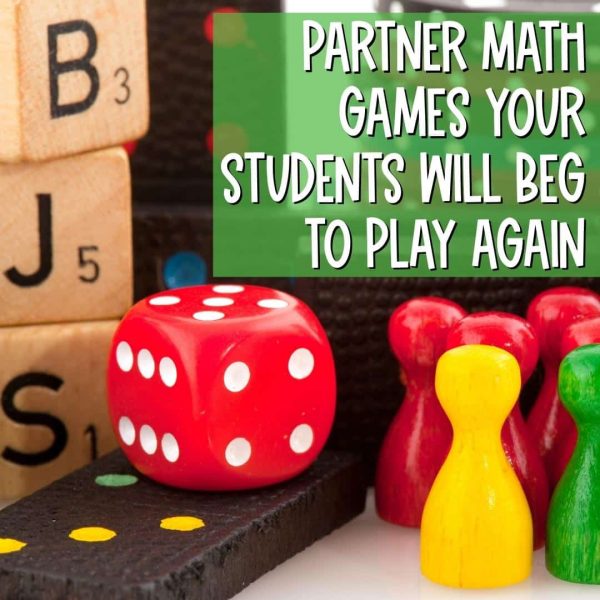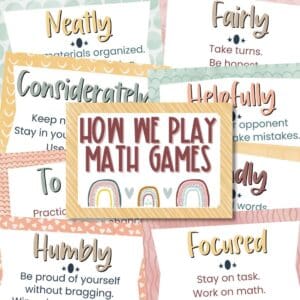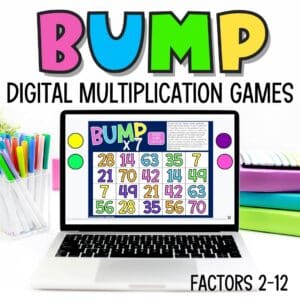Math can be a tricky subject for some, and when teaching math it’s important to keep students engaged and interested. Partner math games are the perfect way to make learning math fun and interactive, which means you’ll want to introduce some math games behavior expectations with this free downloadable poster set. Then, sit back and enjoy watching your students build collaboration skills and help reinforce key concepts. Let’s look at some of the ways you can use partner math games in your upper elementary classroom!
Speed Games
Get your students hyper-focused on the math skill at hand by adding some speed thinking to the mix. The fan-faves in my classroom can be easily adapted for addition or multiplication facts. The first one is Face Off, where two players stand facing each other with their hands behind their backs. Each player forms a number on their fingers while their hands are hidden. One player gives the signal “ready, set, shoot” and both players reveal the number on their hands. The first player to find the product (or sum) of the two numbers earns a point.

For the second speed game, you’ll need one die and one pencil for the pair of students and an empty multipication table (or addition table) for each student. On “go”, one student starts filling in facts on their table while the other player rolls the die. As soon as the player rolling the die rolls a six he/she says “SIX” and the players switch tasks. It’s a full-on race to see who can fill out most of their multiplication or addition table before game time ends.

Kaboom Games
This game will test those math muscles and have kids wanting to play again and again. Students will practice the current math skills and see how far many problems they can solve correctly before a bomb hidden in the mix of problems goes “kaboom”. Stock up on kaboom games for these math concepts:
- 2-digit by 1-digit multiplication
- 4-digit by 1-digit multiplication
- Subtracting mixed numbers
- Measurements for weight
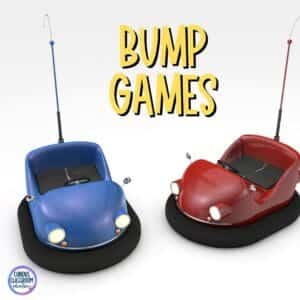
Bump Games
By this point, Bump is an elementary school classic…but it’s classic for a reason. Kids LOVE it! Partners take turns solving problems (for literally any math concept) and covering the answer on a Bump board. The players take turns solving math problems, covering answers, and bumping each other off when an answer gets repeated. Looking for a Bump Game for a specific topic? Here you go!
- Properties of Addition
- Multiplying by multiples of 10
- Division facts
- Area model fractions
- Fractions on a number line
- Measurements for length
- Division Bump (estimating division by 1-digit numbers)
- Algebraic patterns
- Equivalent fractions
- Subtracting fractions
- Metric Measurements
- Angle measurement
There’s even a digital Bump for multiplication facts
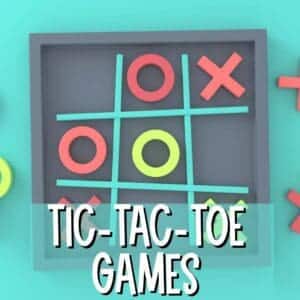
Tic Tac Toe Games
Has tic-tac-toe been around since the dawn of time? Maybe. But it’s so simple and therefore super adaptable for all kinds of academic content. You just need answers on the tic-tac-toe board that match the questions on X and O cards. You can find premade tic-tac-toe games for all these topics:
- Place Value
- 3-digit subtraction across zero
- Multiplication facts word problems
- Equal and unequal parts-intro to fractions
- Subtraction of larger numbers across zero
- Area model fractions
- Complementary and supplementary angles
- Measurements for capacity

A Few Other Favorite Board Games
I have had some math games fanatics in my class over the years…here are a few of their favorites partner math games that didn’t fit in one of the categories above:
- Sum Stingers (3-digit addition)
- Snowball Sums (adding fractions)
- FREEBIE–Sink or Swim (multiplication by multiples of 10, 100, and 1000)
- Arrays Craze (2-digit multiplication)
- Spot to Spot (beginning long division)
- Division Word Play (long division)
- Which One Doesn’t Belong (pattern rules with input output tables)
Partner math games are an effective and fun way to teach upper elementary math concepts. They engage students by providing them with opportunities for collaboration and creativity while still reinforcing key concepts such as multiplication facts or problem-solving skills. So next time you plan out your lesson give partner math games a try – you (and your students) won’t regret it!

